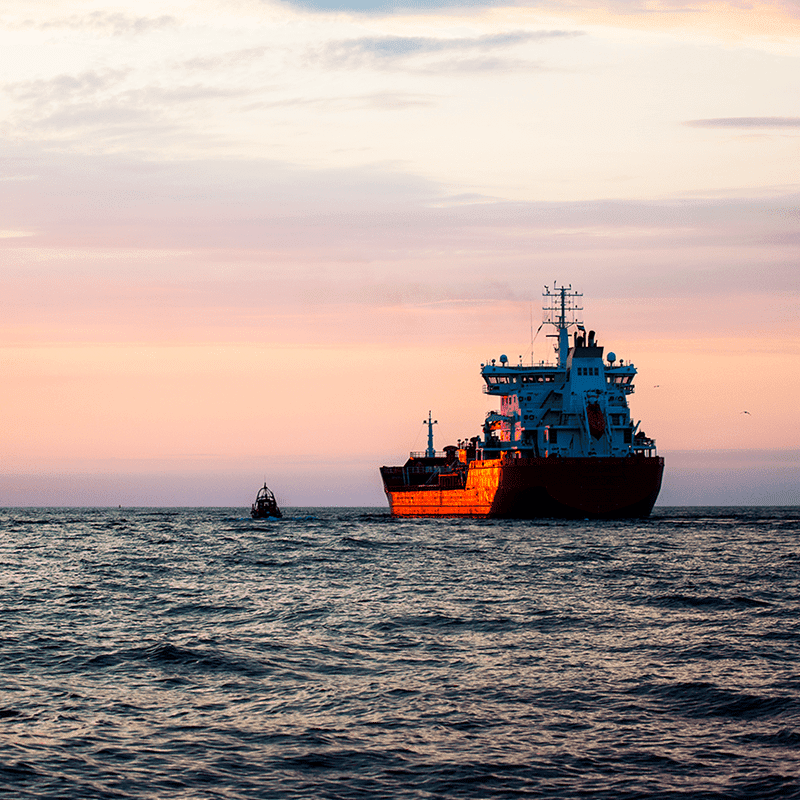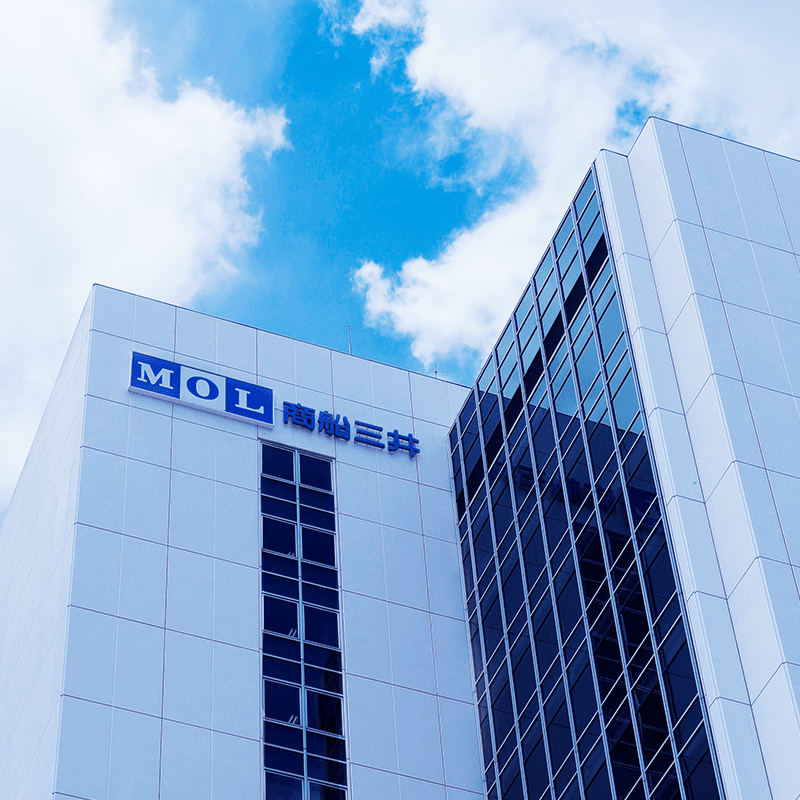BLOG
What is CCUS and how is it expected to be Carbon Neutral? (1)
- Eco Friendly
2021.12.14
CO2 is one of the causes of global warming and its emission reduction has become a global issue. Various efforts are being made worldwide to achieve carbon neutrality and CCUS (Carbon Capture, Utilization and Storage) has been in the spotlight. This blog is divided into two parts and in the first part we will introduce five points that you should know about CCUS.
CO2 Concentration in the Atmosphere Broke the Record Again in 2020
About half of the CO2 emitted by human activities remains in the atmosphere, and the rest is absorbed by the oceans and terrestrial ecosystems. The ratio of CO2 remaining in the atmosphere is called the AF (Airborne Fraction) and that is considered an important indicator of the balance between carbon sources and sinks.
AF varies greatly depending on the year, and the annual average over the past 60 years has fluctuated between 20% and 80%. However, looking at the long-term, there has been no significant change in the average AF of 42%. This means that the ratio of CO2 emitted by human activities remaining in the atmosphere has not changed for 60 years, although the CO₂ emissions have increased greatly compared with that of 60 years ago. That indicates the absorption of CO₂ by land and the oceans continues to increase in proportion to the amount of CO₂ emitted.
The CO₂ absorption process is sensitive to changes in climate and land use, so there is possibility that the amount of CO₂ absorbed by terrestrial ecosystems could reduce as a result of, for example, increased droughts and wildfires caused by ongoing climate change.
In addition, the rise in sea surface temperature, the decrease in pH due to CO₂ absorption, and slowing down of ocean circulation caused by melting ice could decrease the amount of CO₂ absorption by ocean ecosystem. In other words, the increase of extreme weather events in the future, AF may change in rapidly and global warming may accelerate. The change in AF has significant meaning in achieving Paris Agreement target of limiting global warming to temperatures well below 2 °C.
The World Meteorological Organization (WMO) reports that the amount of greenhouse gases reached a new record again in 2020. This trend continues in 2021, with global energy demand and CO₂ emissions are expected to increase by the recovery of economic activity from COVID-19.
(Reference Materials: WMO) Greenhouse Gas Bulletin
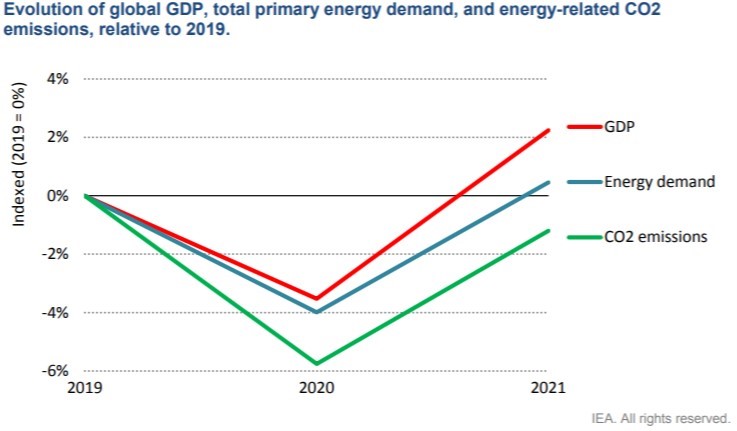
Evolution of global GDP, total primary energy demand and energy related CO2 emissions, relative to 2019
(Source: Global Energy Review 2021)
In November 2021, COP 26 (the 26th Conference of the Parties to the United Nations Framework Convention on Climate Change) was held in Glasgow, the United Kingdom. In 2015, the Paris Agreement set a long-term goal of "Keeping the global average temperature increase well below 2 °C, compared with pre-industrial levels and striving to limit it to 1.5 °C". However, in COP 26, it was recognized that Earth has already warmed at least 1.1°C since the Industrial Revolution, and agreed with setting the agenda on climate change for the next decade with the target, “keeping alive” a 1.5°C limit on global warming.
The IPCC has estimated that limit global average temperature increases 1.5°C requires a reduction of CO₂ emissions of 45% in 2030. In order to achieve this ambitious targets, COP 26 calls on countries to accelerate the “phase-down” of coal, curtail deforestation, speed up the switch to electric vehicles, and encourage investment in renewables.
How can we reduce CO₂ emissions?
In October 2020, the Japanese government declared that "Japan aims to reduce greenhouse gas emissions to zero by 2050, i.e. achieve Carbon Neutrality and a Decarbonized Society by 2050. Furthermore, in April 2021, the government announced their determination to "reduce greenhouse gas emissions by 46% from 2013 levels by 2030 and to keep challenging to achieve a 50% reduction".
In order to achieve this reduction target, various efforts are being made. Reducing greenhouse gas emissions through for example, the promotion of renewable energy and all-electric homes, and absorbing carbon dioxide by reforestation or afforestation. In addition, other attempts are being made to reduce emissions at steel mills, power plants, and factories. Among these efforts, CCS/CCUS is drawing attention.

What is CCS/CCUS ? How it can play a role to reduce CO₂ emissions ...
Thermal power generation, which uses “fossil fuels” such as oil and coal, emits large amounts of CO₂. CO2 is one of the causes of global warming. However, thermal power generation can ensure a stable supply of energy because it is not affected by weather conditions and relatively inexpensive. Therefore, various efforts are being taken to reduce CO2 emissions (low-carbonization) from thermal power generation.
Carbon Capture and Storage (CCS) is one of the methods. CO₂ is captured from the emitted gas and injected deep into the ground and then stored permanently.
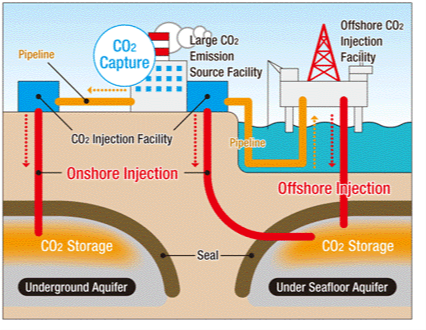
CCUS Flow Source: TOYO ENGINEERING
https://www.toyo-eng.com/jp/en/solution/ccus/

CCUS Flow Source: The ministry of the Environment https://www.env.go.jp/earth/brochureE/ccus_brochure_0212_1_E1.pdf
CCUS (Carbon Capture, Utilization and Storage), a concept that adds “Utilization” to CCS, is also attracting attention.
There are 4 main steps in how CCUS works. Details of each step will be introduced in the second part of the blog, but a brief overview is as follows:1. Capturing CO₂ from other gases produced at factories and plants.
2. Transport by pipelines, tanker trucks, ships, railways, etc.
3. Injecting CO₂ into deep underground (onshore/offshore) and stored permanently (CCS).
4. Enhancing oil recovery (EOR) by injecting CO₂ into existing oil fields, or reuse CO₂ as a raw material (CCUS)
The chemical properties of CO₂
CO₂ is odourless, colourless, incombustible, and exists as a gas at atmospheric pressure (0.1013 MPa) on the ground. When pressurized, this gas becomes a liquid, but if it is cooled down to below -78.5 °C at the atmospheric pressure, it becomes a white solid (dry ice). If this dry ice is left in the atmosphere, it immediately returns to its gaseous from. CO₂ has the nature that it sublimates and does not become a liquid form at the atmospheric pressure.
To summarize, CO₂ has the following properties:
1. CO₂ cannot be liquified under atmospheric pressure (0.1013 MPa).
2. Gaseous CO₂ is liquefied by compressed and cooling. However, when its temperature exceeds 31.1 °C (critical temperature), it cannot be liquefied any more no matter how much compressed. On the other hand, the pressure that liquefaction begins at 31.1 °C, is 7.382 MPa (critical pressure).
3. When the liquefied CO₂ is further cooled, it becomes a solid condition (dry ice) at -56.6 °C and 0.518 MPa.
4. The point where the three states of gas, liquid and solid exist at the same time is called the triple point (-56.6 °C and 0.518 MPa). CO₂ cannot keep liquid condition at the pressure below 0.518 MPa.
5. CO₂ is colourless, odourless, incombustible. When dissolved in water, it becomes weakly acidic and corrosive to metals. It is colourless and transparent in liquid form, and translucent and milky white in solid (dry ice).
6. The density of liquefied CO₂ is 1.030 kg/l (-20 °C and 1.967 MPa).
It is about twice as heavy as liquefied propane (0.582 kg/l) and LNG (0.46 kg/l).
7. For ocean transport, it is more efficient to liquefy and reduce its cubic volume to 1/550.
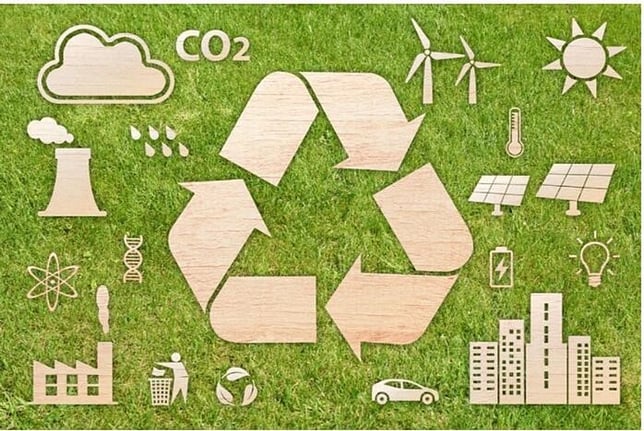
Source: Agency for Natural Resources and Energy
How to transport by ship...
Transporting in liquid form is the best way in the view of efficient loading/off-loading and mass volume of CO₂. Liquefied CO2 has been transported by ship on a small scale in Europe for food and beverages from production sites to coastal area. At present, all CO₂ are transported under medium temperature and pressure conditions (15 -18 bar, -25 ℃) and there is no experience of transporting CO₂ under lower temperature and pressure conditions, or high pressure conditions.
Tanks are the key for the transportation by ship. The tank for liquefied CO2 has to be built by steel plate with certain thickness in order to contain the pressures required to keep CO2 in the liquid phase. For high temperatures and pressures, thicker plates should be needed, which is heavier therefore the cargo volume per shipment is restricted.
On the other hand, under low temperature and pressure conditions, tanks can be thinner, making it possible to increase the size of tanks and ships. However, its temperature and pressure approach the triple point, where CO₂ easily changes into a solid, liquid, and gas, therefore, there is an risk that CO₂ becomes dry ice during transportation, especially in cargo loading/offloading. For these reasons, CO₂ is currently mainly transported under medium temperature and pressure conditions.
In March 2021, MOL acquired a 25% stake in Larvik Shipping, a Norwegian company that has been managing liquefied CO₂ ships for food and beverages for more than 30 years in Europe, and entered into the liquefied CO₂ ocean transport business in earnest. We aim to provide liquefied CO₂ transportation service that matches the needs of our customer, through the liquefied CO₂ transport know-how owned by Larvik Shipping and our accumulated knowledge of safe operation.
Click here for the related press release
In this, the first part, we introduced the problematic impact of CO2 on global warming and the nature and marine transportation of CO2. In the second part, we will discuss the challenges of CCUS an innovative low-carbonization initiative, the current status of initiatives in Europe, and carbon recycling.
Please click on the link below to view a summary of our CCS/CCUS business.


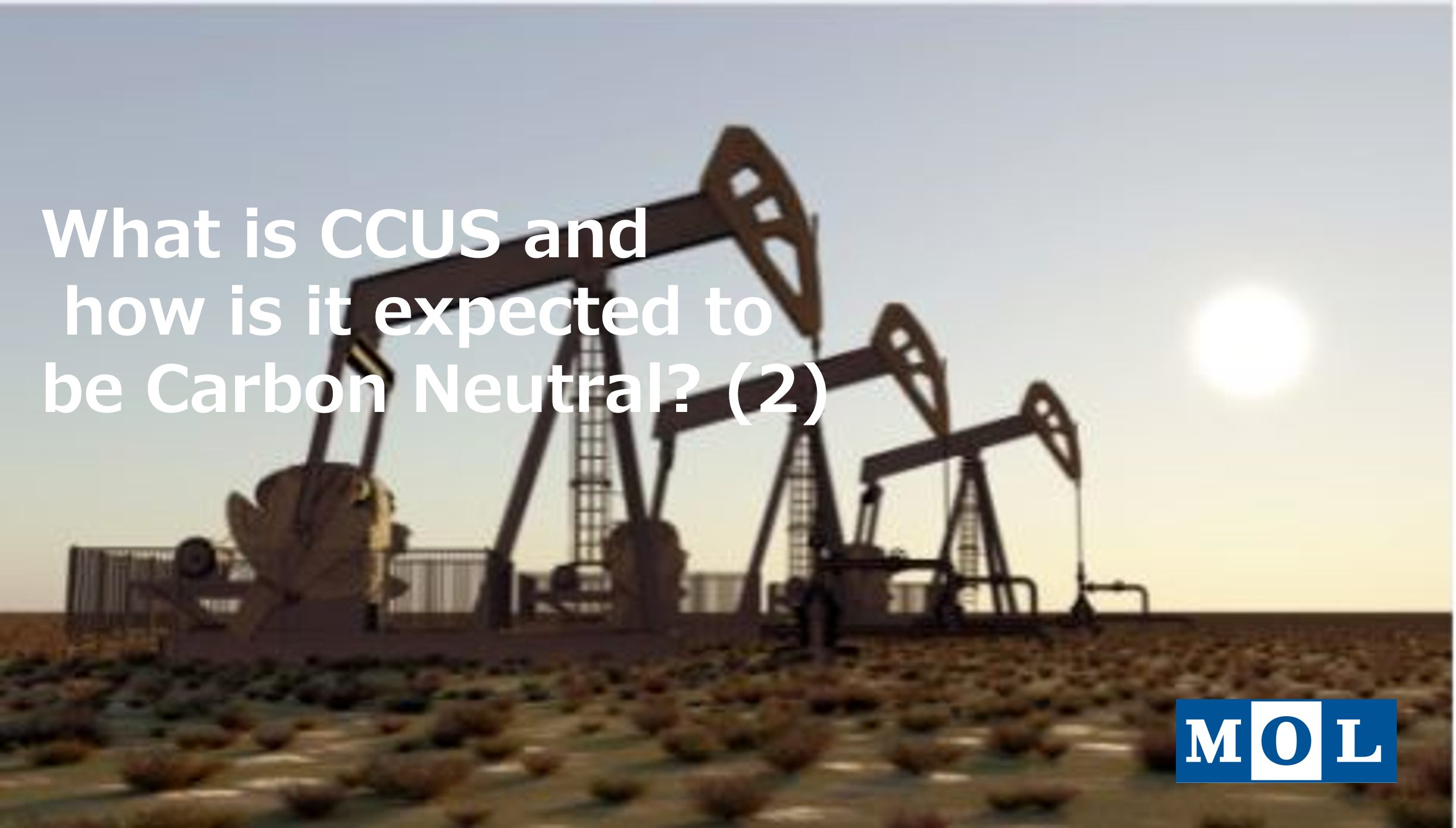

Writer:Ayu
Joined MOL in 2008. I’ve been in charge of operating oil tankers and bulk carriers for abt 7 years. And now I am currently involved in the operation of this site, in the marketing department.
I'm also in charge of managing MOL’s LinkedIn account. Please follow us! My favorite is K-Pop music :)
Recommended Articles
2022.07.05
- General Shipping
2021.04.13
- Energy
2023.12.19
- General Shipping
2021.08.07
- Eco Friendly
2025.03.18
- General Shipping
Latest Articles
2025.12.09
- Eco Friendly
- General Shipping
2025.12.03
- General Shipping
2025.11.20
- Energy
- General Shipping
CCUS%20DL%20material_FINAL_AT.png)

.png)


